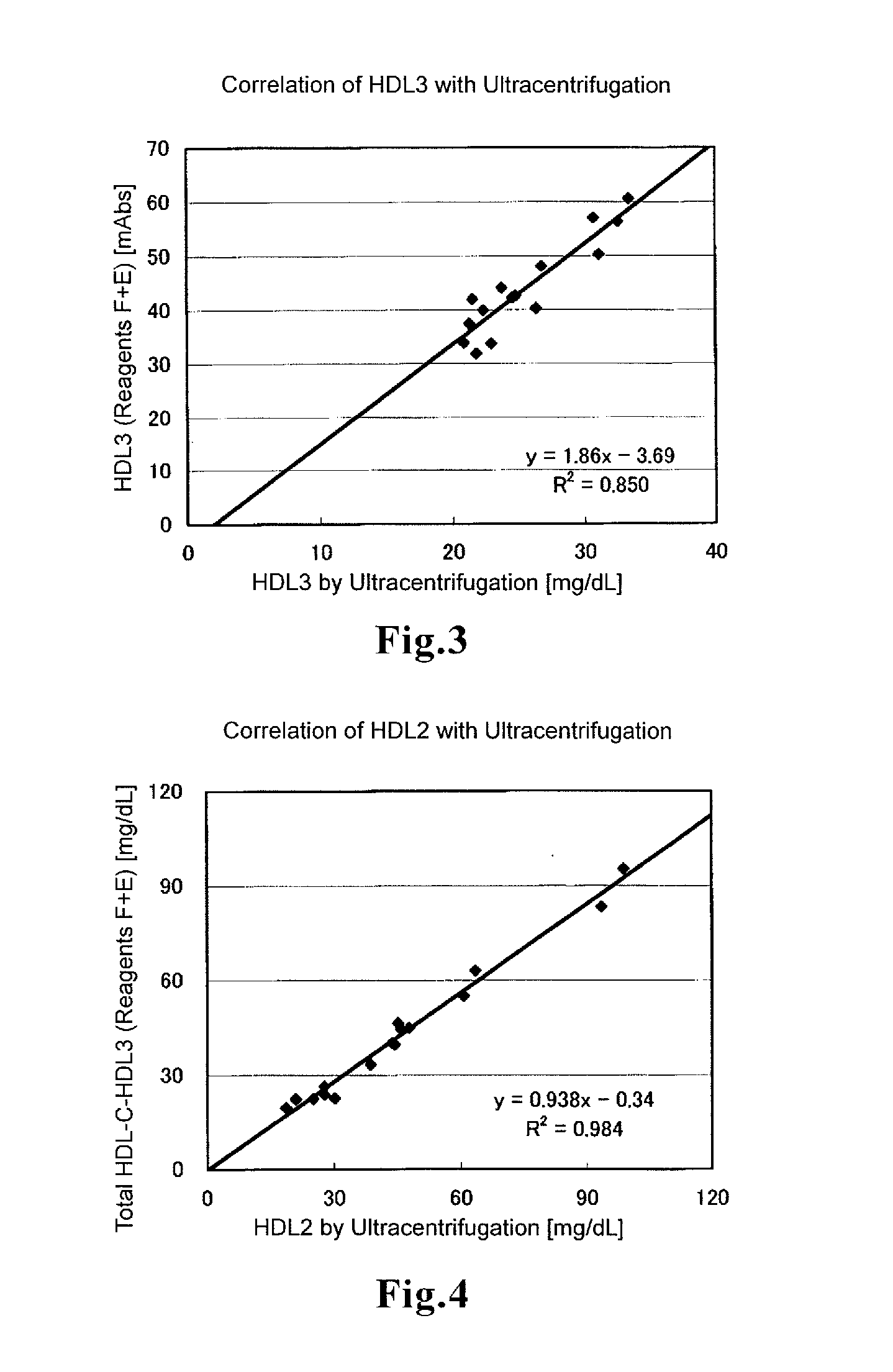Method for quantifying cholesterol in high density lipoprotein 3
a high density lipoprotein and cholesterol technology, applied in the field of cholesterol quantification in high density lipoproteins, can solve the problems of high cost, many days, and difficulty in operation, and achieve the effect of improving the accuracy of the measurement method
- Summary
- Abstract
- Description
- Claims
- Application Information
AI Technical Summary
Benefits of technology
Problems solved by technology
Method used
Image
Examples
example 1
[0047]Fractionation was carried out to obtain the HDL2 fraction and the HDL3 fraction as follows. A test sample containing HDL, that is, serum was subjected to ultracentrifugation using a solution with sodium chloride and sodium bromide such that separation occurs at a density at the border between HDL2 and HDL3 (1.125), and each resulting fraction was collected.
[0048]Fractionation by ultracentrifugation was carried out to obtain the CM-VLDL fraction, LDL fraction, HDL2 fraction and HDL3 fraction, and each fraction was reacted with Reagent A described below. Reagent B described below was further added to the reaction solution to perform measurement. In the measurement, 150 μL of Reagent A was added to 2 μL of each fraction, and the reaction was allowed to proceed for 5 minutes with warming, followed by addition of 50 μL of Reagent B to the reaction solution and additional 5 minutes of reaction with warming. The absorbances at a main wavelength of 600 nm and a sub-wavelength of 700 n...
example 2
[0050]Fractionation by ultracentrifugation was carried out to obtain the CM-VLDL fraction, LDL fraction, HDL2 fraction and HDL3 fraction, and each fraction was reacted with Reagent C described below. Reagent D described below was further added to the reaction solution to perform measurement. In the measurement, 150 μL of Reagent C was added to 2 μL of each fraction, and the reaction was allowed to proceed for 5 minutes with warming, followed by addition of 50 μL of Reagent D to the reaction solution and additional 5 minutes of reaction with warming. The absorbances at a main wavelength of 600 nm and a sub-wavelength of 700 nm were measured.
Reagent CBES buffer (pH 6.6)100 mmol / LHDAOS0.56 mmol / LNonion OT-2210.01 w / v %Catalase600 U / mLCholesterol oxidase 0.8 U / mLCholesterol esterase2.8 U / mL
Reagent DBES buffer (pH 7.0)100 mmol / LSodium azide0.1%Newcol-6102.0w / v %4-Aminoantipyrine 4.0 mmol / LPeroxidase3.5 U / mL
[0051]The amount of the change in absorbance of each fraction at a unit time after...
example 3
[0052]A human serum sample was reacted with Reagent A described above, and Reagent E described below was further added to the reaction solution to perform measurement. In the measurement, 150 μL of Reagent A was added to 2 μL of serum, and the reaction was allowed to proceed for 5 minutes with warming, followed by addition of 50 μL of Reagent E to the reaction solution and additional unit time of reaction with warming. The absorbances at a main wavelength of 600 nm and a sub-wavelength of 700 nm were measured to determine HDL3 cholesterol level, and HDL2 cholesterol level was determined by calculation based on the total HDL cholesterol measured otherwise.
Reagent EBES buffer (pH 7.0)100 mmol / LSodium azide0.1%Newcol-7102.0 w / v %4-Aminoantipyrine4.0 mmol / LPeroxidase3.5 U / mL
[0053]The correlation between HDL3 cholesterol level determined by using Reagent A and Reagent E and HDL3 cholesterol level determined by precipitation method (Patent Document 1) is shown in FIG. 1. The correlation b...
PUM
| Property | Measurement | Unit |
|---|---|---|
| density | aaaaa | aaaaa |
| density | aaaaa | aaaaa |
| temperature | aaaaa | aaaaa |
Abstract
Description
Claims
Application Information
 Login to View More
Login to View More - R&D
- Intellectual Property
- Life Sciences
- Materials
- Tech Scout
- Unparalleled Data Quality
- Higher Quality Content
- 60% Fewer Hallucinations
Browse by: Latest US Patents, China's latest patents, Technical Efficacy Thesaurus, Application Domain, Technology Topic, Popular Technical Reports.
© 2025 PatSnap. All rights reserved.Legal|Privacy policy|Modern Slavery Act Transparency Statement|Sitemap|About US| Contact US: help@patsnap.com


